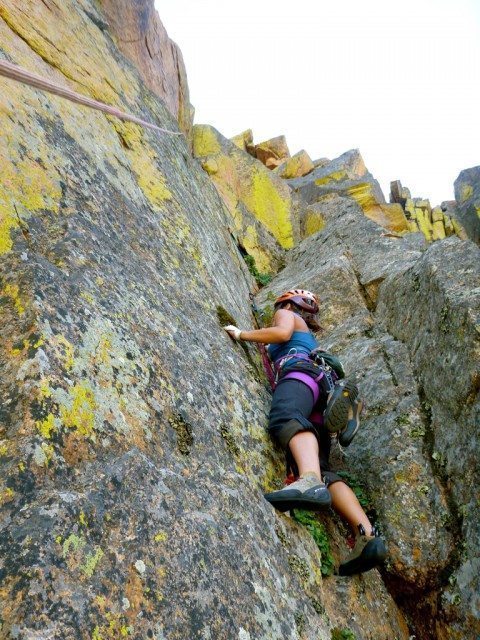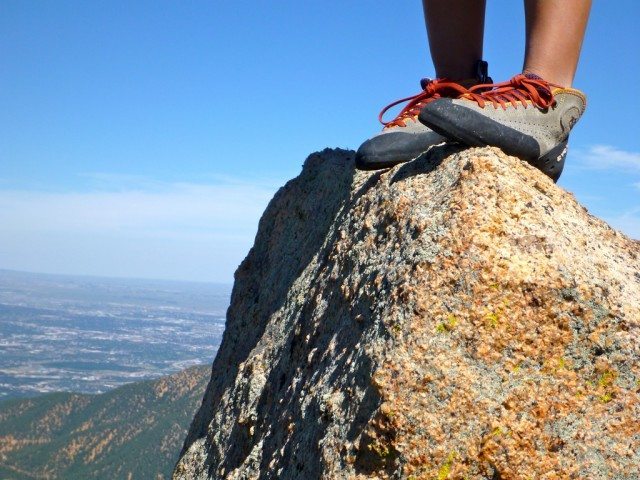Evolv Astroman
Sizes: 4 — 13.5 (U.S. men’s, including half sizes)

Profile: Slightly asymmetric
Sole: MX-P: 1mm half-length + 2mm full length
Rand: VTR rand (thicker front toe area)
Upper: Split leather
Lining: Microfiber forefoot, cotton heel
Midsole: MX-P: 1mm half-length + 2mm full length
MSRP: $145
My Foot: Small, average shape, narrow heel, medium arch
Street Shoe Size: 5-5.5
Size Tested: 5.5
Days climbed: ~20
Locations: Turkey Rocks, Shelf Road, somewhere on Old Stage Road, Boulder Canyon, Monitor Rock, CO
When it comes to trad climbing, I expect my shoes to do a very specific job: stick to almost everything and be comfortable. Really, it comes down to a matter of confidence—if I’m climbing scary trad or placing pro at my limit, I need to know that my feet aren’t going to give out. With that said, I had high expectations for the Astroman.
Blister’s climbing editor Dave Alie wrote an excellent review of the Astroman earlier this year. He found the shoe to be a great choice for long routes in the alpine or in extended crack systems, calling it a “focused weapon” for trad climbing and all-day use.
It’s worth noting that Dave is 6’3″, 185 lbs., and wears a size 13 shoe.
I’m just a tiny bit smaller: 5’2″, 107 lbs., and I wear a size 5.5.
Given that Dave and I are on pretty opposite ends of the sizing spectrum, we thought a second look at the Astroman was in order. Turns out, I disagree with him on a few key points, and those points seem to have quite a bit to do with our respective sizes. But we’ll get to that discussion in a bit. First, a word on fit and sizing.
Fit / Sizing
I have to admit that I’ve become a full-blown TC Pro convert ever since I reviewed that shoe last year, and the Astroman is very different than the TC Pro. One notable difference between these two shoes is the fit. I got the Astroman in a size 5.5 (just about my street shoe size), hoping that it would be a good fit for a trad shoe. However, I found that because of the shape of the shoe (more on this below), the 5.5 wasn’t actually that comfortable straight out of the box, and required some serious breaking in.
The shape of the Astroman (particularly the wide, flat toe box), made me wish I’d gone up a half size. This was surprising since I’ve found Evolv’s other shoes to run a bit large. I’d say the Astroman seems to fit about a half size tighter than other Evolv shoes like the Geshido and the Elektra.
Shape
The Astroman is a very flat-toed shoe (no downturn to speak of), and just barely asymmetric. What I found most intriguing was the shape of the Astroman’s toe box, which is very flat and wide. The TC Pro toe box is much narrower (as is typical of La Sportiva), and much roomier top-to-bottom.
The Astroman’s shape is Evolv’s attempt to solve an age-old dilemma with trad and crack-climbing shoes:
- Climbers want their crack shoes to be narrow enough in the toe box that they easily slip into very thin cracks, but…
- We don’t want a shoe so narrow and tight that it hurts to jam. A highly down-turned bouldering shoe would easily fit into a finger or tips crack, but it would be so incredibly painful to twist and jam into the crack that few people would wear it.
Climbing shoe companies have come up with a range of designs to try to this problem. Even though its not the most comfortable option, Five Ten’s Moccasym is very thin and very soft and it gets rid of a lot of extra bulk (i.e. laces, padding, a tongue, etc.), thus allowing the shoe to fit in much thinner cracks.
Then there’s Evolv’s “flat-and-wide” design. It’s very different from the Moccasym and from the TC Pro, which in my opinion both fits and performs exceedingly well.
I initially hoped that the wide toe box would be roomier and therefore more comfortable than the TC Pro. But my feet found the flat shape uncomfortable, causing hot spots on my fourth and big toes in both shoes.

Performance
Evolv designed this shoe with the help of renowned climber Peter Croft, and its meant to give climbers all-day comfort. The company took an approach similar to that of La Sportiva, giving the Astroman a stiff sole to improve edging and create a strong platform to stand on. (In contrast, shoes like the Mocassym use a very thin, soft rubber to enhance smearing and the ability to slot into tiny cracks.) Unlike the La Sportiva TC Pro, the Astroman’s sole felt so stiff to me that I could hardly smear on any holds.
- Sensitivity
The stiff platform of the Astroman works incredibly well in hand- and fist-sized cracks, where there is plenty of space for the shoe to rest with minimal need for smearing or any other type of flexing of the sole.
That said, this significant stiffness coupled with the already thick sole reduces the Astroman’s sensitivity. This is the case with all climbing shoes that follow the stiff sole model. However, I felt that the Astroman was unusually stiff in comparison to other shoes, particularly the TC Pro. Although the TC Pro has a relatively stiff sole, the pair that I reviewed wore in over about ten days of climbing so that the toes were able to flex a bit over holds, as I need them to do when I’m smearing or edging over tiny holds.
Even after about 20 days, the Astroman still has not worn in in a similar manner. This keeps the shoe’s sensitivity incredibly low. With the TC Pros, I often have to look down at my feet in order to ensure highly dialed placements. But with the Astroman, it feels as though I’m looking down at my feet constantly since I can hardly feel anything under my shoes.
The stiffness and lack of sensitivity of these shoes also inhibited my ability to slot my feet into tiny cracks. While climbing, it felt as though the toe was simply too stiff to conform to the sides of thin cracks or even smear effectively around them.
Further Thoughts on Sizing
As I mentioned above, I found Dave’s review of the Astroman very interesting. At size 13, his feet are more than seven sizes larger than mine. He found that the stiffness of the shoe worked well for both foot jams and edging, and that the toe box was a comfortable fit for his wider feet. This leads me to believe that our different opinions are due to our differences in weight and to our vastly different shoe sizes.
Of course, our feet are shaped differently as well. I find that the La Sportiva shoes tend to fit me very well, so it’s no surprise that I prefer the TC Pro to the Astroman. However, I think that the Astroman may be a better shoe for those with larger, wider feet. A climber with smaller feet who also weighs less might have more difficulty bending and flexing the shoe’s proportionally stiffer sole.

